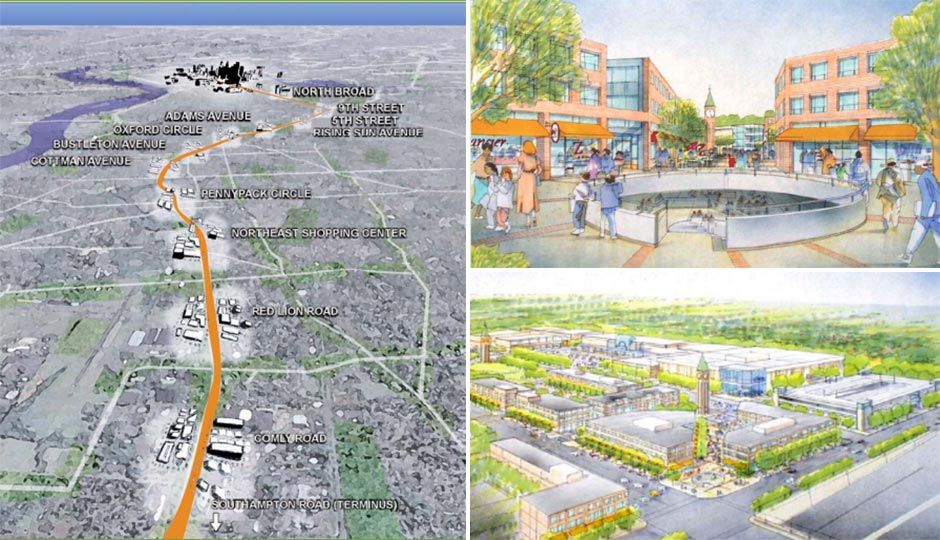The Roosevelt Boulevard Subway Is Dead … Unless It Isn’t

SUBWAY DAYDREAMING: Renderings of (clockwise from left) the Roosevelt Boulevard Subway Extension viewed from the Northeast and two views of a proposed Northeast town center at Cottman Avenue Station, all circa the Philadelpha City Planning Commission’s 2003 Roosevelt Boulevard Corridor Study.
If you haven’t been paying attention to tunnel-digging news out of the Pacific Northwest — and, I get it, you probably haven’t — you should know that out in Seattle they have a giant tunnel-boring machine called “Bertha,” and that Bertha got stuck a few hundred feet into its job of digging a two-mile-long highway. She was finally freed last month for repairs and once she’s back in business, work on the long-stalled project to replace an aging freeway viaduct will resume.
Total price tag for the two-mile tunnel: $3 billion.
Why should anyone in Philadelphia care about this?
Well, according to at least one regional planning official quoted in the press, that’s about how much it would cost to build a subway-elevated line (including a tunnel) more than four times as long along Roosevelt Boulevard (though, okay, another study put the price tag closer to $4.6 billion).
The Roosevelt Boulevard subway, first proposed formally in 1913, is Philadelphia’s answer to New York’s Second Avenue line: The Subway Idea That Refuses to Die. There have been two attempts to actually build the darn thing, one station built and demolished, and a slew of studies that have come to the conclusion that Yes, This Is Something We Should Build, and At Long Last, Everyone Agrees It Should Be Built.
As recently as 2008, the Boulevard subway remained a top-priority item in the Delaware Valley Regional Planning Commission’s Long-Range Vision for Transit, for several reasons: It has the potential to transform the Northeast into the regional satellite center it should be, based on its population. It offered the promise of turning the Northeast’s “downtown,” Roosevelt Mall, into a pedestrian-friendly, mixed-use town center. It would dramatically improve the commute to Center City for upwards of 124,000 riders a day, more than ride the Broad Street Line today (the subway would connect to the Broad Street Line at Erie station using a connection already in place).
And there was momentum too. SEPTA, which many critics charged was insufficiently focused on the future, had several proposals of its own for regional rail transit improvements, one of which (the Route 100 extension to King of Prussia) now appears on track to become reality. The city had another expansion project on the boards, a Broad Street Line extension to the Navy Yard that would help advance plans to make the yard a true live-work-play environment. And recent projects such as the return of all-night subway service on weekends indicated that SEPTA was willing to respond to public demands for more and better service.
In short, the Boulevard line offers the promise of bringing more of Philadelphia into the 21st century and improving the quality of life in the place where Philly’s other future is taking shape. So why aren’t we building it? Don’t we have a couple of billion dollars lying around somewhere?
THE ANSWER, IT turns out, is: We don’t. Even though just about everyone, including Northeast residents themselves, is on board with the subway, the 50 percent local match required for federal New Starts transit construction funding is beyond the city’s reach. As a result, the subway is off the table as a to-do list item on the region’s transit agenda.
But don’t write its obituary yet, because everyone with a stake in the Boulevard’s future has come to the conclusion that it’s time to completely remake the entire street — and that means that, some time down the road, a region better positioned to undertake the project could dust the Boulevard subway off once more.
“It’s clear that Roosevelt Boulevard doesn’t work for anyone. Not people who drive on it, not people who take transit, not bicycle users, not people who walk across it,” said Denise Goren, director of policy and planning at the Mayor’s Office of Transportation and Utilities (MOTU), when I put the subway question to her.
The 12-lane behemoth is the most pedestrian-hostile street in the entire city. It’s so wide that SEPTA buses that cross it stop on both sides of the intersection, which a typical Northeast resident couldn’t cross in a single signal cycle if her life depended on it. And her life just might depend on it, for the road is also home to some of the city’s worst intersections: two of them made an insurance company’s list of “10 Most Dangerous Intersections in America” in 2002, and while pedestrian crashes are far more numerous in Center City and on Broad Street, if we were to adjust for differences in pedestrian volume, we might find that a given pedestrian is more likely to get hit crossing the Boulevard than crossing Broad Street. And bicycling? Fugeddaboutit. The Boulevard has no provision for bicycle traffic at all, and the fact is that cars often zoom down it as though it were a freeway, ignoring the 40- and 45-mph speed limits, make bicycling on it a hair-raising experience.
“So what’s broken about the Boulevard is more than a matter of high-speed transit,” Goren said. “Looking at the street holistically is the subject of where we are today.”
•
WHERE MOTU IS is on the verge of beginning a comprehensive study of the whole Boulevard, funded by a Federal TIGER grant awarded late last year. TIGER stands for “Transportation Investments Generating Economic Recovery,” and it’s the infrastructure component of the “stimulus package” passed in President Barack Obama‘s first year. It’s already delivered some benefits locally in the form of I-95 reconstruction and two modernized Broad Street Line stations, all of which were deemed “shovel ready.” Now, however, the program is also funding projects which take a longer-range view, and that’s where this study comes in.
The study will bring together all the parties with a stake in the road’s functioning — PennDOT, SEPTA, the Streets Department, the City Planning Commission, MOTU and the civic organizations that represent the neighborhoods through which the Boulevard passes — to come up with ways to make the street function better for everyone for years to come.
The study, Goren said, aims to take the long view of the Boulevard’s future evolution. The Northeast itself has changed a great deal since the road took its current form in the 1950s. Philadelphia has re-emerged as an immigrant gateway, and many of those immigrants have made the Northeast their home; in part because of them, the Lower Northeast is the third-fastest-growing area of the city, according to the Planning Commission. These changes mean that the shopping centers along the Boulevard may eventually have to cater to people who arrive on foot or by bike as the population grows and its demographics shift. “We need to figure out how the land is going to be used 50 years from now,” Goren said.
Because of this, she continued, the Boulevard study will actually be “a series of simultaneous study efforts to come up with things you can actually program.” In other words, this comprehensive plan is not designed to go on a shelf once it’s complete, as so many other previous transportation studies of the Boulevard have.
Another goal is to develop solutions to the Boulevard’s problems that can be implemented incrementally over time, so that as needs and conditions change, the street won’t need to be completely torn up and reconfigured again as it was in the 1950s. “We need to tear up the Boulevard and put it back together for the future, not the past,” Goren said.
•
LAST WEEK THE city received the last of the proposals it solicited from local design and consulting firms to conduct the study, and Goren, who is heading the project, is eager to soak up as much input on possibilities as possible:
- Depressing the inner lanes and turning them into a freeway? Worth considering.
- Dedicated bike lanes? Yes.
- Intersection improvements to make both car and pedestrian crossings safe, and provision of facilities for faster transit service? All on the table.
That last is where a subway might still come in … some day. “If you ride the 14 bus along the Boulevard, it takes twice as long for you to complete the trip than if you drove a car. That is simply an unacceptable level of service,” Goren said. And one of the “alternative concepts for reconfiguration of Roosevelt Boulevard” specifically called for in the study’s request for proposals is “transit service operating in a dedicated guideway.”
I don’t know about you, but a “transit service operating in a dedicated guideway” sounds an awful lot like a subway to me. But then again, it could be light rail, or even bus rapid transit. Goren noted that the study aims to come up with strategies for improving the Boulevard that can be revised or upgraded over time as conditions change. And since the aim of the process is to come up with some solutions that can be put in place right away, it may be that the best will be deferred while the good can be put in. If it’s done right the first time around, an improved Roosevelt Boulevard could have everything in place to accommodate bicyclists, make life for pedestrians easier, and offer some form of rapid transit that can be upgraded when the money becomes available. Bus rapid transit is cheap; a subway isn’t.
And funding matters. The agencies involved, Goren said, are committed to implementing the changes the study recommends, and it’s highly likely that even if they come up with a $2 billion package of improvements, the money might need to be spread across several projects. Or there might not be that much money. As the entire planning process is just getting off the ground, it’s too soon to say what form new transit — or any other improvement — on the Boulevard will take, or what the price tags will be.
All that can be said right now is that it will be an interesting process to watch. “How can we make this the best complete street in America?” is the main question Goren said the study sought to answer. And like those Seattleites still waiting for that new tunnel, we may just have to wait a while for that answer. But the good news is, we can’t assume a Boulevard rapid transit line is off the table. We may just have to wait a little longer for it. That’s okay; we’ve been waiting since 1914, so what’s a few more decades?
Follow @MarketStEl on Twitter.


